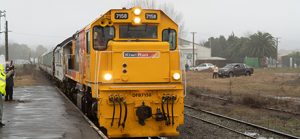Regular log trains began running between Wairoa and Napier Port in New Zealand on Sunday 26 January following completion of the new log yard in Wairoa. The log trains were reopened following funding through the Provincial Growth Fund which enabled the rail line to reopen. Source: Timberbiz
The NZ Government invested NZ$6.2 million to reopen the mothballed rail line which was closed after significant storm damage in 2012.
“Moving forwards, now that our logging yard consents are in place, we will usually run two trains a week, on Saturdays and Sundays,” KiwiRail Chief Operating Officer Todd Moyle said.
“Each train could take up to 50 long distance truck hauls off the road between Napier and Wairoa, with 66% fewer emissions per tonne of freight carried by rail compared to trucks.
“Log export forecasts, however, show a wall of wood will be ready for export within 18 months, and the volume of logs harvested will continue to grow over the coming years, so there is plenty of room for the services to grow.
“Growing this business will assist local businesses to harvest and transport large volumes of logs, help bring profitability to KiwiRail, benefit the East Cape region with less congestion and road wear and tear, and bring added benefits from lower emissions.
“We welcome the involvement of ISO Ltd at Wairoa as the log marshaller for KiwiRail. That allows logs to be scaled for export off port and that improves efficiency for delivery onto port.”
Export log volumes in the Hawke’s Bay region are predicted to reach 3.3 million tonnes per annum in the next few years and remain at high levels until the mid-2030s. The harvest growth around Wairoa is part of that picture.
Trains will be carrying 1400 tonnes of logs each weekend, with more train services expected as harvests increase. That means 5000 fewer truck journeys between Wairoa and Napier
a year.
Forestry harvests across New Zealand have been increasing since 2008. They are currently at around 36 million tonnes per year, and are forecast to remain at high levels for the next decade.








